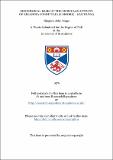Files in this item
Biochemical basis of the muscular activity of erlangia cordifolia (S.Moore) - (Gathuna)
Item metadata
| dc.contributor.advisor | Tristram, George Roland | |
| dc.contributor.author | Mugo, Njuguna John | |
| dc.coverage.spatial | 175 p. | en_US |
| dc.date.accessioned | 2018-07-02T11:25:57Z | |
| dc.date.available | 2018-07-02T11:25:57Z | |
| dc.date.issued | 1976 | |
| dc.identifier.uri | https://hdl.handle.net/10023/14801 | |
| dc.description.abstract | Water extract of the leaves of Erlangla cordifolia (S. Moore) - compositae (commonly known in Gikuyuland as Gathuna) has been traditionally used by the Gikuyu people of Kenya for centuries for the purpose of stimulating myometrial contractions in the process of parturition. The use of this extract has been called for when the progress of the birth process has been judged to be unsatisfactorily slow. The introduction to this work (Chapter 1) therefore surveys this use of the plant material and proceeds on to show the validity of using Erlangia material for the study of the process of muscle contraction. The section also includes a short discussion on the validity of the use of what could be termed a pathological condition - that is, the obstetric 'lazy' uterus - for the purpose of studying a normal physiological process (muscle contraction) at the cellular and molecular levels. Chapter 2 explains the methods used to obtain the crude extract from Erlangia leaves andvalso a purified compound, cordifene, from the same source, that was found by the author of this work to have stimulatory activity on contracting muscle. The chapter also deals with the methods used to characterize cordifene chemically. Chapter 3 describes the physiological experiments carried out to confirm the stimulatory activity of Erlangia extract and also of cordifene on the smooth muscle of the myometrium and that of the intestinal wall, in addition to similar effects on skeletal muscle. These experiments therefore confirmed the fact that the activity of Erlangia material has a common biochemical basis for all types of muscle at the molecular level. Stimulation of muscle contraction can be brought about through biochemical effects on the nerve(s) supplying the muscle or through direct effects on biochemical mechanisms occurring within the muscle cell itself. Chapter 4 of this work is therefore concerned with an investigation into the possibility of a chemical compound or compounds from Erlangia leaves that may be capable of influencing biochemical processes within the peripheral autonomic nervous system, as this system is known to be intricately involved in muscle contraction. Acetylcholine metabolism is important not only for the autonomic nervous system's biochemical role in muscle contraction: it is also important for the biochemical processes that take place in nervous impulse transmissions in general - with all the consequences that this has on all muscles, both voluntary and involuntary. For this reason, a possible effect of Erlangia material on the cholinesterase enzymes has been searched for Chapter 5 is concerned with a series of investigations into the different biochemical processes that occur in the muscle cell during the contractile activity and the mode of action by which Erlangia material might be influencing such processes. Chapter 6 is a discussion based on the results of the investigations reported in the previous sections. Erlangia material was found to react with ADP forming a complex and, besides probably inducing increased myosin ATPase activity, it was also found to induce marked configurational changes within the actomyosin molecule. (Abstract shortened by ProQuest.) | en_US |
| dc.language.iso | en | en_US |
| dc.publisher | University of St Andrews | |
| dc.subject.lcc | QP321.M9 | |
| dc.subject.lcsh | Muscles--Physiology | en |
| dc.title | Biochemical basis of the muscular activity of erlangia cordifolia (S.Moore) - (Gathuna) | en_US |
| dc.type | Thesis | en_US |
| dc.contributor.sponsor | University of St Andrews | en_US |
| dc.type.qualificationlevel | Doctoral | en_US |
| dc.type.qualificationname | PhD Doctor of Philosophy | en_US |
| dc.publisher.institution | The University of St Andrews | en_US |
This item appears in the following Collection(s)
Items in the St Andrews Research Repository are protected by copyright, with all rights reserved, unless otherwise indicated.

